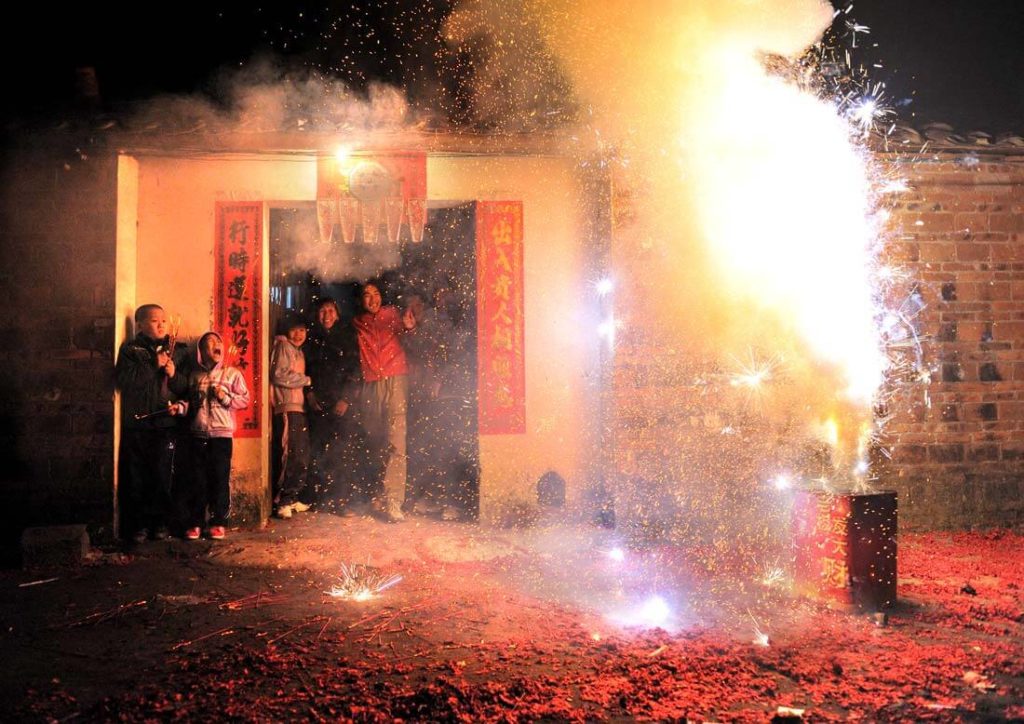Chinese New Year Symbols
Lion and dragon dances are essential part of Chinese celebrations. They are especially popular at Southern China. Dragon has always been regarded as positive character in China as it is also the god of rain, which is of course utmost important for agriculture. That is the reason why dragons need to attend all the Chinese annual celebrations. Lion, which have never really lived within the borders of China, is the guardian god. The role of the lion at the annual celebration was to scare away demons and evil spirits. It was crucial to start the New Year without the presence of any malicious spirits.
As for outdoor performances, Kung Fu (Gōngfū 功夫) at its’ different forms has been favored for a long time. Kung Fu performances are based on Buddhist monks’ meditation and self-defense practices. In Chinese these different types of Kung Fu are called Wǔshù 武术 which means martial skills. Little by little they developed into independent forms of exercising.
Welcoming New Year with Loud Noises
Gunpowder is one of the Four Great Inventions from China (the other three are papermaking, compass and printing). It is tricky to tell when exactly was the gunpowder invented, but it is commonly believed it happened during the 8thCentury. Gunpowder is vital component of fireworks, but Chinese people knew their ways to make noise even before gunpowder. One way was to toss bamboo sticks to fire. Once they heated up, they would explode with a boom. Loud noises were seen as one of the best ways to scare off evil spirits, which is why fireworks are still fundamental pert of Chinese celebrations.

New Year Paintings
Creating New Year paintings is approximately 300 years long tradition of folk art. When New Year is drawing close, Chinese bookstores start to sell these paintings. Right before New Year the people will hang these painting to their walls and by the doors in order to protect their homes and to attract good luck, sons, prosperity and long life. New Year paintings are particularly widespread at the vast countryside of China, but these days one can spot them more and more easily at the cities as well.
New Year’s paintings are symbolic pictures and with a rich variety of themes. Often they present scenes from classic novels, poems and folk tradition. The themes also include landscapes, flowers, birds, mythological creatures and foremost plumb, cheerful children as symbols of well-being. Prosperity is symbolized by large fishes and peaches that also represent fortune and longevity.
Devil Vanquisher Zhong Kui
One of the favorite character of New year paintigs is guardian figure Zhong Kui (Zhōng Kuí钟馗). Famous writer of Song Dynasty Shěn Kuò (沈括) tells the story of talented scholar Zhong Kui of Tang Dynasty, who was on his way to take the imperial examination when a group of evil demons took a part in his destiny. Demons spelled Zhong Kui to make him look ugly and scary. However he managed to escape demons’ trap and made it in time to the examination. He even excelled in the examination and got the best possible grades. But tradition stated the Emperor himself will greet the best candidates of the examination and confirm their achievement. Once the Emperor set his eyes on Zhong Kui, he got so terrified of his looks that he annulled his examination score. Obviously this was the greatest possible loss of face for talented scholar and there was only one way out – honor suicide. However Zhong Kui was a man of principles and guardian of his younger sister after their parents had passed away. Therefore Zhong Kui first ensures that his sister was married off well (another typical topic of New Year paintings) and took his own life only after settling this matter.
But this was not the end of Zhong Kui’s story. After his suicide, Zhong Kui appeared to the dreams of Emperor Ming (明皇). In the dream Zhong Kui told the Emperor his whole story and that he had decided to fight against the demons and monsters even after his own death. Emperor woke up dripping with sweat and understood he had wronged this gifted scholar. Emperor summoned his court painter and asked him to immortalize Zhong Kui as the highest devil vanquisher of the country, which was the honorary title granted to Zhong Kui by the Emperor after his death.
Since Song Dynasty, portrait of Zhong Kui has been used in Chinese homes as vanquisher of evil spirits and bringer of good luck. Zhong Kui is portrayed scary and warlike looking, who wears official uniform and is pointing to a bat flying right towards him – symbol of good luck coming from the skies.
